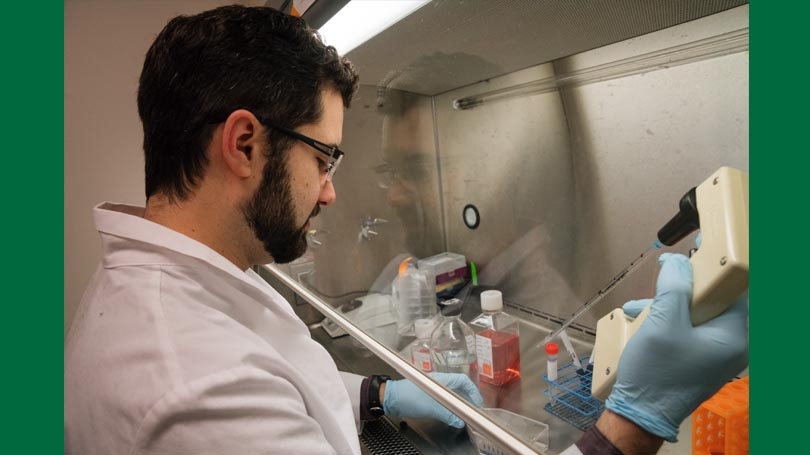
Dartmouth PhD candidate, Nicholas Warren, and his thesis advisor, Dr. Alan Eastman, published a paper on their research that demonstrates how a new class of drugs sensitize cancer cells to a standard chemotherapy.
Developing new cancer treatments is often complicated by poor understanding of how new therapies kill cells. A recent article published by Dartmouth PhD candidate, Nicholas Warren, and his thesis advisor, Dr. Alan Eastman, demonstrates how a new class of drugs sensitize cancer cells to a standard chemotherapy. Understanding how a therapy functions helps identify which patients might benefit the most and provide a rationale for how to schedule drug combinations for the greatest efficacy.
For over 50 years, standard chemotherapies have worked by damaging DNA, the molecules that make up our genetic code. DNA exists as two intertwined strands of billions of conjoined molecules, but both strands need to be duplicated without errors during cellular replication. DNA damaging drugs preferentially target cancer cells because they divide more frequently with fewer error checks. However, chemotherapies also damage healthy cells like the ones that make new blood cells or regenerate our intestinal lining – a process that generates a lot of negative side effects.
Think of a cancer cell as a factory in the business of synthesizing new DNA strands based on the existing template. Using DNA damaging drugs is like throwing a wrench into the machinery; many forms of DNA damage cause physical blocks to DNA synthesis proteins. If the factory were to continue running, you might make a faulty product or start a fire; just like how mutations or cell death can occur.
Over the millennia of evolution, animal cells (including humans) have evolved an emergency shut down system called the DNA checkpoint. The DNA checkpoint supervises the process of DNA synthesis checking for errors. Like a factory safety officer, the DNA checkpoint hits the emergency off button and calls in contractors to repair the broken machines when there is a problem. The DNA checkpoint is the main reason why we can go out in the sun or be exposed to other carcinogens and not get cancer the next day. However, the DNA checkpoint also helps cancer cells overcome DNA damage, which is why current treatments fail to cure many patients. The good news is that cancer cells often lay off a number of their safety officers, placing a greater burden on the remaining safety officers to find problems. This makes cancer cells susceptible to a new type of therapy which Mr. Warren studies.
Checkpoint Kinase 1 (CHK1) is a critical component of the DNA checkpoint. Many pharmaceutical companies have attempted to develop inhibitors of CHK1 as a monotherapy and in combination with many standard chemotherapies, to try to shut off the DNA checkpoint. Part of the challenge in developing CHK1 inhibitors is that it was poorly understood how they kill cancer cells.
The study published in the Journal of Biological Chemistrydemonstrated how CHK1 inhibition sensitizes cancer cells to the chemotherapy, gemcitabine. Gemcitabine is used to treat pancreatic, breast and lung cancers and is being pursued in several ongoing clinical trials in combination with CHK1 inhibition. Gemcitabine does not directly damage DNA, instead it prevents cells from making the building blocks of DNA. Using gemcitabine is like blocking the bottom of a dispenser for raw materials at the beginning of the assembly line; cells cannot make DNA, because the materials are not available.
Mr. Warren found that inhibiting CHK1 in cells treated with gemcitabine was able to turn the replication machinery back on, but they were running without making any new DNA. Within a few hours, this unwound too much double-stranded DNA into highly unstable single-stranded DNA. Essentially, the template catastrophically fell apart without any way to recover it. Lacking the code essential to stay alive, the cells died.
Surprisingly, inhibiting CHK1 at the same time cells were treated with gemcitabine failed to keep the replication machinery active; CHK1 inhibitors only sensitized cancer cells when given 18 or 24 hours after gemcitabine. The reason for the delayed efficacy depended on switching to dormant sites of replication that were not affected by the initial insult from gemcitabine. These findings will help clinical trial design by providing rationale to administer CHK1 inhibitors 18 to 24 hours after patients receive gemcitabine.
Another surprising finding was that CHK1 inhibition sensitized gemcitabine-treated cells through a different mechanism than when CHK1 inhibitors are administered alone. Previous workin the Eastman Laboratory showed that CHK1 inhibition alone abnormally activates an enzyme that chews up DNA, causing wide spread damage. However, a far smaller proportionof cancer cell lines are susceptible to CHK1 inhibition monotherapy compared to the proportion that are sensitized to gemcitabine. CHK1 inhibition monotherapy also requires that CHK1 is shut off for far longer than in combination therapies in order to kill cells. This suggests that different patient populations may respond better to different therapies including CHK1 inhibition and there are likely additional ways CHK1 inhibitors can kill cancer cells with other combination therapies. Further validation of methods to predict which patients will respond to specific therapies is critical to the future clinical development of this promising class of new cancer drugs.
This research was made possible by funding through the National Cancer Institute.
If you are interested in learning more, Nicholas Warren’s public thesis defense will be held at 10am on Monday, February 18thin DHMC’s Auditorium H. The Advance Transit Blue bus runs between Hanover and DHMC’s Cancer Center Entrance every 15 minutes.